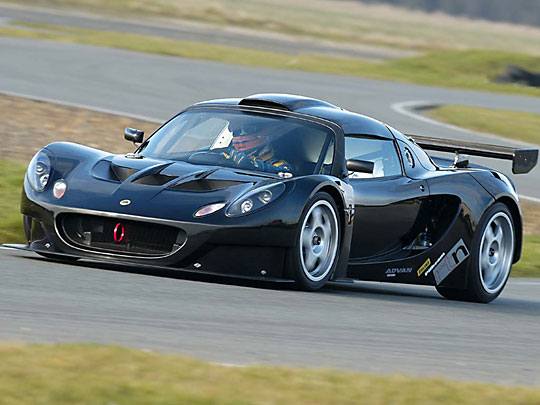
Lotus Sport Exige
470 hp/tonne Race Ready Sport Exige Debuts at Autosport International Show
Lotus Sport, the performance division of Lotus Cars Ltd., has developed the new Lotus Sport Exige, a direct motorsport derivative of the successful Lotus Exige.
The Lotus designed and engineered racecar was part manufactured by RTN, the team responsible for the Le Mans winning Bentley, using the latest motorsport techniques and procedures to produce a lightweight yet strong carbon-fibre bodywork structure around the standard road-going Lotus Exige Aluminium extruded and bonded chassis.
The Lotus Sport designed fully adjustable suspension system with double wishbones all round was fabricated and manufactured by Pilbeam. Power is provided by a 400 hp Swindon Racing Engines tuned GM 3 litre V6 racing engine linked to a Hewland sequential six-speed gearbox, with AP-Racing providing the braking system.
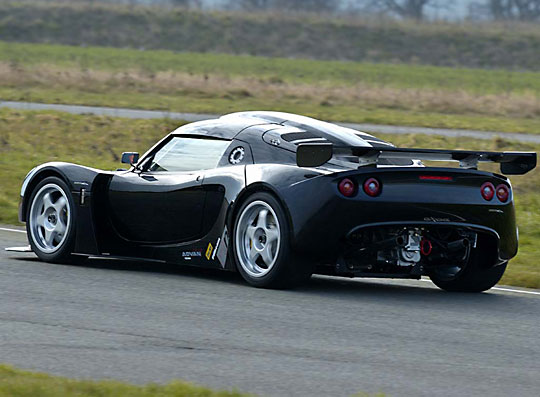
This one-off racecar has been built for a South East Asian client and is expected to race in selected sportscar races in Asia. There are no plans as yet to build further examples of the Lotus Sport Exige but the base structure has been carefully designed to comply with key motorsport regulations around the world. Adhering to the key Lotus philosophy of performance through lightweight, the Lotus Sport Exige weighs in at just 850kg.
The whole project, conducted in complete secrecy has taken less than 6 months and the car will run for the first time at the 2? mile Hethel test track in mid January.
Chris Arnold, General Manager for Lotus Sport explains the philosophy behind the Lotus Sport Exige:
"The Lotus Sport Exige is a competition car developed directly from the road going Exige. The racecar uses the existing tub with only minor modifications, and careful design has enabled Lotus Sport to package an upgraded powertrain assembly whilst maintaining an equivalent weight to the existing road car. When this package is combined with further improvements to suspension and bodywork, it produces a fantastic looking car with great track potential.
The car has been taken from concept to reality in only six months and I thank all our engineering partners and the staff at Lotus who have worked so hard on this fantastic project."
As the Lotus Sport Exige is, at present, a one-off racecar, a price cannot be given for the racecar package.
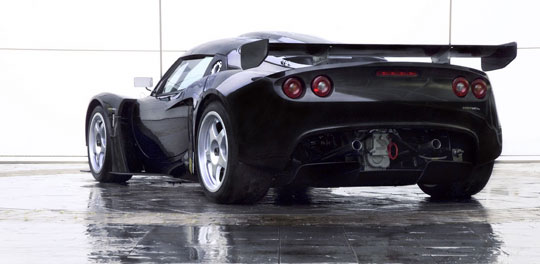
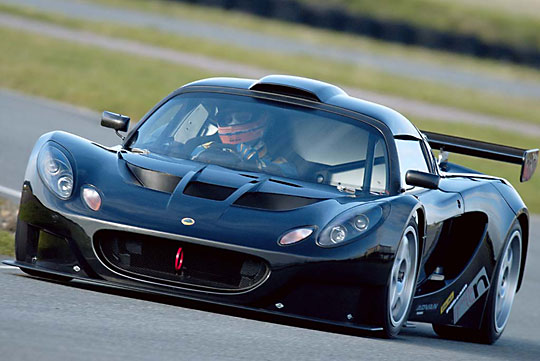
The Lotus Sport Exige in more Detail:
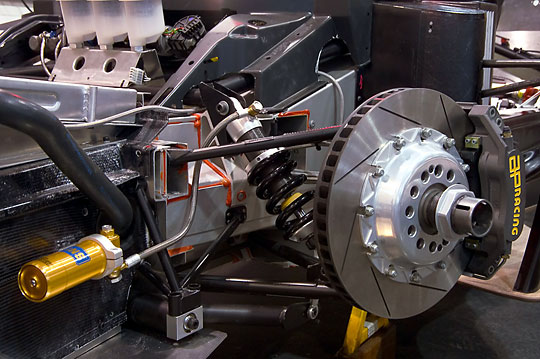
Chassis and suspension systems
The Lotus Sport Exige is directly developed from the road-going Lotus Exige that was unveiled at the Geneva Motorshow in 2004. The heart of the Sport Exige is the bonded and extruded Aluminium Chassis, the technology for which was first introduced in the Lotus Elise in 1995. The Exige chassis, which is also used in the Lotus Elise 111R, is the latest development of this award winning structure and weighs 68kg and has a torsional stiffness of 10500 Nm/degree. Made up of 25 separate extrusions, and bonded with an epoxy adhesive, the chassis in the Lotus Sport Exige is an exceptionally stiff, strong and lightweight structure. This Lotus technology is so world-leading that it has been used on other non- Lotus products including high performance production front-engined V12 and V8 GT cars.
An FIA approved 8-point roll cage has been bolted to the chassis, prior to the bodywork being fitted.
Double wishbone front suspension is mounted to the same suspension hard points as the road-going Lotus Exige, whilst the rear suspension picks up to a revised rear subframe. However, being a full racecar, there is adjustment for ride height, camber and castor, as well as adjustable front and rear anti-roll bars. Coil springs are mounted over Ohlins ST44 3-way adjustable dampers front and rear.
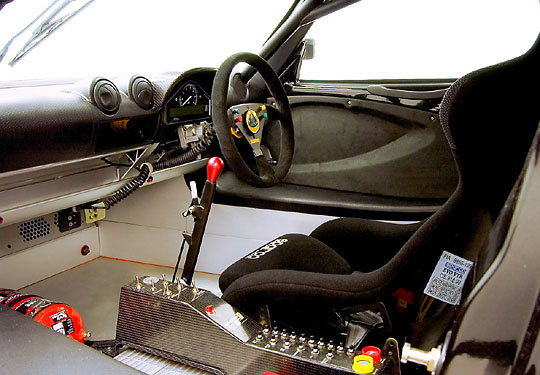
The Body
Lightweight "Z-Preg." carbon fibre bodywork was specially manufactured for Lotus by RTN, the team responsible for the Le Mans winning Bentley. These panels (front clam, "A" panel, body side and sill, roof, engine cover and rear clam) have been made using an innovative low temperature curing process. The moulds were taken directly from the Sport Exige styling "clay" and the resulting carbon fibre panels are race-ready without having to rely on the costly tooling process used in current carbon fibre technology. This is thought to be the first time that this technology has been used on such large carbon fibre panels.
An aerodynamically developed front splitter, carbon fibre rear diffuser and an adjustable carbon rear wing provide increased levels of downforce. The interior of the Lotus Sport Exige is similar to the standard Exige, but the standard roadcar wiring harness is replaced with a full Raychem 25 system incorporating Mil-spec connectors from Beru Formula 1 Harnesses. Conventional fuses are replaced with circuit breakers, and a Stack display with integrated data recording is fitted as standard.
A racing bucket seat (driver side only) is mounted as right hand drive to optimise weight balance through right hand corners (most circuits run clockwise). A six-point seat belt, prepared for using HANS Safety System, and a removable steering wheel (with quick-connect coupling) is included in the interior package.
The composite energy absorbing crash structure used on the standard road cars is also carried over to the Lotus Sport Exige. This glass fibre composite structure, around five times more energy absorbing than the equivalent steel component, also houses the larger water radiator and provides efficient cooling and air ducting over the carbon front clamshell.
A 100 litre FT3 safety fuel cell (with quick refuelling system) is mounted behind the driver and in front of the engine (as with the road-going Exige). A fully plumbed in electrical fire extinguishing system completes the body package.
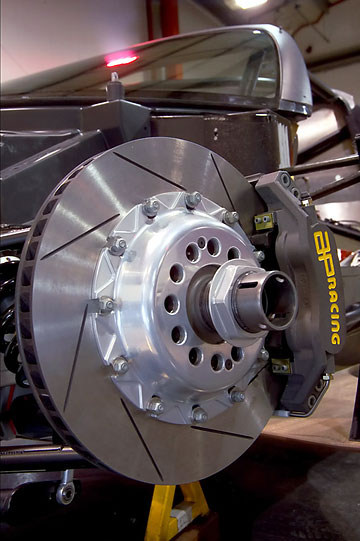
Brakes
AP Racing provides the non-ABS braking system, which includes the pedal box (with brake balance bar and cylinders). AP Racing also provides the powerful six piston brake calipers at the front and four piston brake calipers at the rear. These calipers are mated to vented discs (344 mm diameter at the front and 330 mm diameter at the rear).
Rims and Tyres
Ultra lightweight OZ Racing Chrono single-piece cast magnesium rims (8.8J x 17 ET40 at the front and 11.25J x 18 ET50 at the rear) are shod with Yokohama tyres (250/610-17 at the front and 280/650-18 at the rear).
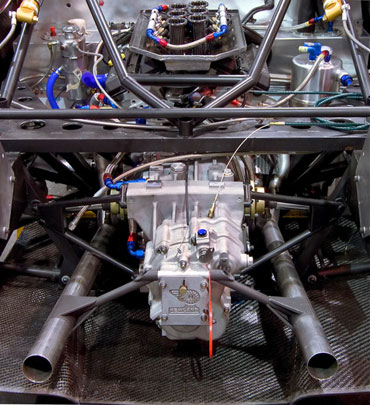
Powertrain: Engine and Transmission
A narrow angle V6, 2,998 cc Swindon Racing Engines tuned GM racing engine is mounted longitudinally in the Lotus Sport Exige. The naturally aspirated 32-valve engine produces 400 hp (296 kW or 405 PS) at 7,750 rpm and 294 lb.ft (398 Nm or 40.6 kgm) of torque at 6,500 rpm and has a maximum engine speed of 8,250 rpm. When the light weight of the Lotus Sport Exige is taken into consideration, the power to weight ratio is a phenomenal 470 hp / tonne (0.351 kW/kg or 476 PS/tonne). The engine itself weighs 157 kg.
Breathing is via an F1-style airbox and air snorkel from the roof panel of the Sport Exige directly into the six carbon fibre air trumpets.
The dry-sump engine, with a bore of 89.0 mm and stroke of 93.7 mm is water cooled and also uses an oil-water heat exchanger to efficiently cool the oil. The whole engine is controlled by a Motec M600 electronic engine management system fitted inside the cockpit.
The power is transferred from the engine to the rear wheels via a single mass stepped flywheel, AP Racing twin-disc cerametallic race clutch and Hewland NLT sequential six-speed dog type transmission (with in-line shift mechanism). The gearbox itself is cooled through an oil-water heat exchanger. A limited slip differential (separate power and brake ramp angles) completes the powertrain package.
Design
The one-off racecar has been designed by Barney Hatt (Principal Designer for Lotus Design), under the direction of Russell Carr (Chief of Design). Taking the already aerodynamic road going Exige, Hatt designed the Lotus Sport Exige with the requirements to carry the design of the Exige and the brand attributes of Lotus into a competitive racecar.
Russell Carr explains the work needed to design the Lotus Sport Exige: "The objective was to create a dramatic design and to take into account aerodynamic criteria to produce a race car that was not only competitive but also stunningly good looking. General motorsport regulations also had to be adhered to so the fact that the resulting racecar looks like a natural competition evolution of the road going Exige is a testament to the purity and effectiveness of the original design."
Dimensions
The Lotus Sport Exige is slightly longer (350 mm) and wider (100 mm) than the road-going Exige to accommodate the larger engine, wider track, longer wheelbase and to optimise the aerodynamics. The length is mainly from the cockpit rearwards but the short rear overhang design of the road-going Exige is maintained.
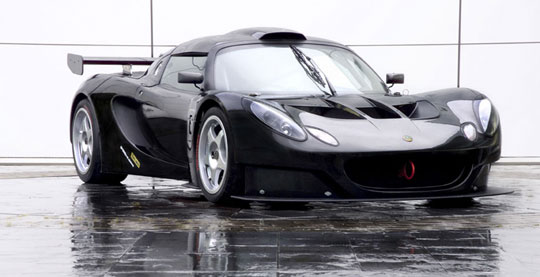
Technical Specifications
Engine
- Narrow (56°) angle V6 engine, water-cooled
- 2,998 cc, stroke 93.7 mm, bore 89.0 mm.
- Max. power: 400 hp (296 kW or 405 PS) at 7,750 rpm
- Max. torque: 294 lb.ft (398 Nm or 40.6 kgm) at 6,500 rpm
- Max. rpm: 8,250 rpm
- Four valve technology
- Oil-cooler (oil-water heat exchanger)
- Dry-sump lubrication
- SRE Multi-roller barrel throttle bodies
- F1 style airbox and air snorkel
- Motec M600 electronic engine management system
- Required fuel quality: 98 octane super unleaded
- Race exhaust: multiple pipe manifold, open exhaust
- No catalytic converter
Note: service limits will apply
Transmission
- Hewland sequential six-speed dog type transmission, straight cut gears
- In-line shift mechanism
- Gear ratios:
- Crown wheel & pinion gear 9:35
- - 1st gear 12:36
- - 2nd gear 15:33
- - 3rd gear 18:30
- - 4th gear 20:26
- - 5th gear 24:26
- - 6th gear 26:24
- Oil-water heat exchanger
- Single-mass flywheel
- AP Racing twin-disc cerametallic race clutch
- Limited slip differential (separate power and brake ramp angles)
- Rear-wheel drive
note: service limits apply
Chassis
- RHD race vehicle developed from Lotus Exige road car
- Lotus bonded aluminium chassis and composite crash structure
- Bolted on 8-point roll cage (in accordance with FIA-Regulations 2004)
- Three-point AP Racing air jack system
Bodywork
- Weight optimised and widened Exige
- Lotus Design RTN "Z-preg." carbon fibre bodywork
- Aerodynamically developed front splitter and rear diffuser
- Adjustable carbon rear wing
- Racing bucket seat (driver side only)
- Six-point seat belt, prepared for using HANS Safety System
- Removable steering wheel (with quick-connect coupling)
- Electrical fire extinguishing system
- 100 litre FT3 safety fuel cell with quick refuelling system
- Total weight of bodywork excluding doors ~ 44 kg
Suspension
- Double wishbone front suspension with spherical bearings
- Adjustable front anti-roll bar
- Non-PAS
- Double wishbone rear suspension with spherical bearings
- Adjustable rear anti-roll bar
- Ohlins ST44 3-way adjustable dampers
- Coil over damper springs front and rear
- Suspension adjustable for ride heights, camber and castor
Braking system
- Non-ABS system
- AP Racing pedal box with brake balance bar and AP Racing cylinders
- Aeroquip style brake lines
- Front AP Racing six piston brake calipers
- AP Racing vented discs diameter: 344 mm
- Aluminium disc bells, race brake pads
- Rear AP Racing four piston brake calipers
- AP Racing vented discs diameter: 330 mm
- Aluminium disc bells, race brake pads
Rims/Tyres
- OZ Racing Chrono single-piece cast magnesium rims:
- F - 8.8J x 17 ET40
- R - 11.25J x 18 ET50
- Yokohama tyres
- F - 250/610-17 *
- R - 280/650-18
- Single central wheel nuts with locking device
Electrical System
- Motec M600 engine management
- Stack display with integrated data recording
- Raychem 25 system wiring looms and Mil spec connectors
- Red Top battery: 12 Volt, 50 Ah
- Twin Bosch fuel pumps with change over switch
- Floor mounted carbon fibre centre switch console
- Circuit breaker switches (no fuses)
- 120 Ah Alternator
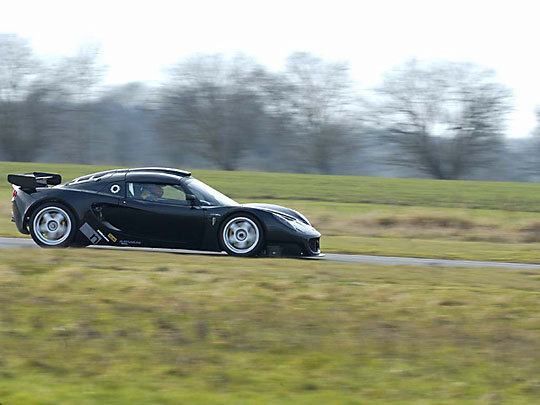
Dimensions
| Lotus Sport Exige | Production Lotus Exige (Road Specification) | |
| Wheelbase | 2500 mm | 2300 mm |
| Track - front | 1545 mm | 1457 mm |
| Track - rear | 1528 mm | 1507 mm |
| Overall length | 4142 mm | 3797 mm |
| Overall width (door mirrors excluded) | 1840 mm | 1727 mm |
| Overall width (door mirrors included) | 1850 mm | 1850 mm |
| Overall height- | 1125 mm | 1159 mm (mid-laden) |
| Overhang - front | 950 mm | 805 mm |
| Overhang - rear | 692 mm | 692 mm |
| Vehicle mass - unladen (running order, full tank of fuel, no occupants, no luggage) | 850 kg | 875 kg (no options) |
Notes:
High-resolution pictures of the Lotus Sport Exige receiving the trophy and Lotus products (Elise and Exige) can be downloaded from the media centre of the official Group Lotus website at http://www.grouplotus.com/mediactr. The image library is for registered users only. Members of the press may register for the media centre.
About Group Lotus plc:
The main operating subsidiary of Group Lotus plc is Lotus Cars Ltd., which has two operating divisions - Lotus Cars and Lotus Engineering: Lotus Cars builds and commercialises Lotus sports cars, Elise and Exige; builds sportscars for General Motors and manufactures the advanced composite front and rear crash structures for Aston Martin V12 Vanquish. Lotus Engineering provides comprehensive and versatile consultancy services to many of the world's OEMs and Tier 1 suppliers, offering a full engineering service from initial concept and project design through development to full production prototype build.
Lotus Sport
Lotus Sport is the performance arm of Lotus Cars Ltd and is located at the Norfolk Head Office next to the famous Hethel test track. The department designs and builds modified versions of the standard Lotus road cars with special emphasis on upgraded performance, improved ride and handling packages and race specific safety equipment. Individual performance parts to customise or upgrade a vehicle are available via Lotus Sport and its workshops can service, repair, restore or upgrade a standard road or competition Lotus. In addition, Lotus Sport provides a range of driving packages using the renowned Hethel test circuit, including driver training and corporate days, as well as offering enthusiasts a guided tour of the Lotus factory.
Lotus Exige
The Lotus Exige is based purely around phenomenal performance and handling, With the advanced 1.8 litre VVTL-i engine producing a maximum power output of 192PS (189hp, 141kw) and 181 Nm (133 lb.ft, 18.5 kgm) of torque, the Exige sprints to 160 km/h (100 mph) in 13.2 seconds before reaching a top speed of 237 km/h. Key to this phenomenal performance and handling is the total aerodynamic package (which gives 41.2 kg of downforce at 160 km/h - 19.3 kg: front and 21.9 kg: rear) and light weight, the latter made possible through innovative engineering and clever design.
Lotus Elise
The Lotus Elise, weighing from 785 kg, is not just one of the lightest sportscars on the market but one of the lightest cars on sale of any type. Three versions of the Elise are differentiated through equipment levels, engine power (120hp, 156hp, 189hp), performance (0-60mph between 5.7 sec's and 4.9 sec's) and top speed (up to 150mph). Coupled with a very strong and stiff aluminium chassis the Elise continues to set standards by which all other sportscars are judged.
For further details please contact:
PR Department Group
Lotus plc
Potash Lane, Hethel, Norfolk, UK, NR14 8EZ
Tel: +44(0)1953 608264
Fax: +44(0)1953 608111
Email: pr@lotuscars.co.uk
Alastair Florance
Group PR Manager
Group Lotus PLC
Tel: + 44 (0) 1953 608462
